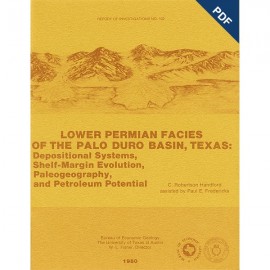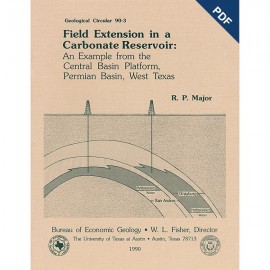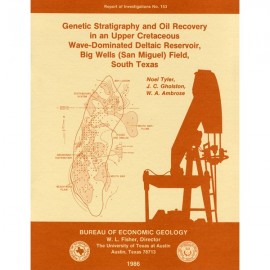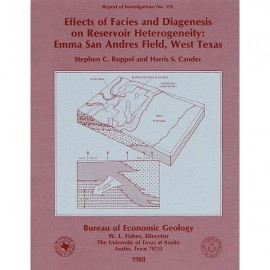Reports of Investigations
-
Books & Reports
- Reports of Investigations
- Guidebooks
- Udden Series
- Geological Circulars
- Down To Earth
- Atlases of Major Oil and Gas Reservoirs
- Texas Memorial Museum Publications
- Environmental Geologic Atlas of the Texas Coastal Zone
- Mineral Resource Circulars
- Other Reports
- Seminars and Workshops
- Handbooks
- Submerged Lands of Texas
- Symposia
- Annual Reports
- Open File Reports
-
Maps & Cross Sections
- Thematic Maps
- Miscellaneous Maps, Charts & Sections
- Geologic Atlas of Texas
- STATEMAP Project Maps
- Geologic Quadrangle Maps
- Cross Sections
- Highway Geology Map
- Energy and Mineral Resource Maps
- Shoreline Change and Other Posters
- Wilcox Group, East Texas, Geological / Hydrological Folios
- Bouguer Gravity Atlas of Texas
- River Basin Regional Studies
- Featured Maps
- Posters
- Teachers & the Public
-
Geological Society Publications
- Gulf Coast Association of Geological Societies
- Alabama Geological Society
- Austin Geological Society
- Corpus Christi Geological Society
- Houston Geological Society
- Lafayette Geological Society
- Mississippi Geological Society
- New Orleans Geological Society
- South Texas Geological Society
- GCS SEPM Publications
- Historic BEG & UT Series
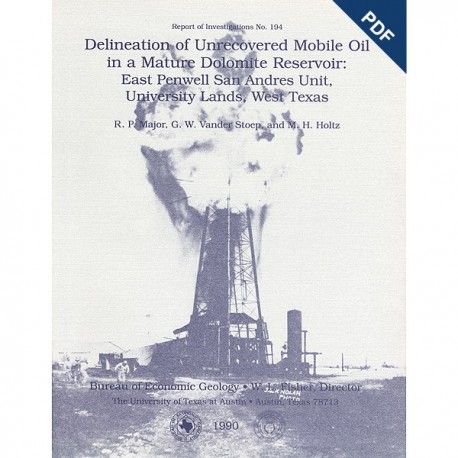
Delineation of Unrecovered ...Oil ...East Penwell San Andres Unit, University Lands... Digital Download
RI0194D
For a print version: RI0194.
RI0194D. Delineation of Unrecovered Mobile Oil in a Mature Dolomite Reservoir: East Penwell San Andres Unit, University Lands, West Texas, by R. P. Major, G. W. Vander Stoep, and M. H. Holtz. 52 p., 51 figs., 2 tables, 1990. Downloadable PDF. doi.org/10.23867/ri0194d
To purchase this publication in book format, please order RI0194.
ABSTRACT
The East Penwell San Andres Unit produces from a depth of approximately 3,400 ft (1,040 m) on the east flank of a broad, low-relief anticline on the east side of the Central Basin Platform of the Permian Basin in Ector and Crane Counties, West Texas. Since discovery in 1927 the unit has produced 43 million barrels of primary and waterflood oil of an estimated 164 million barrels of original oil in place. Approximately 30 million barrels of mobile oil remains in the main reservoir of this unit. This report presents the results of the integration of geologic and engineering studies of the reservoir to locate this remaining mobile oil.
The upper San Andres Formation [Permian, Guadalupian) at Penwell field is composed of an upward-shoaling suite of shallow-marine, carbonate-ramp facies that are now thoroughly dolomitized and that contain sulfates as nodules and cements. The lower, subtidal part of the stratigraphic section is composed primarily of pellet grainstone/packstone containing varying amounts of fusulinids and bivalves and thin zones of sponge-algal boundstone. These facies are overlain by, and/or interbedded with, thin zones of dasycladacean algae grainstone. The upper, peritidal part of the stratgraphic section is composed of nonporous mudstone and pisolite packstone, which form the reservoir seal. Pisolite packstone facies exhibit abundant subaerial-exposure features such as caliche, low-relief karst-collapse structures, and desiccation cracks.
The main reservoir facies, pellet grainstone/packstone, has two diagenetically controlled textures that give the rock a mottled appearance. The darker colored, unaltered texture was found to have permeabilities of approximately 1 md or less and oxygen-isotope compositions in the range of 3 to 5.5%0 (PDB). The lighter colored, altered texture was found to have permeabilities of approximately 10 md or more and oxygen-isotope compositions of 1 to 4%0 (PDB). Alteration was determined to have resulted from late-stage leaching of dolomite, which increased permeability by widening intercrystalline pore throats and preferentially removing early, isotopically enriched parts of dolomite rhombs. Significantly, this diagenetic mottling occurs so minutely and randomly that conventional core-analysis techniques are insufficient to detect it.
Maps of production averaged over time (to remove production/drilling-strategy artifacts such as early drilling along lease lines) and values of calculated remaimng mobile oil revealed production patterns resulting from lateral reservoir heterogeneity. The south part of the unit, where nonreservoir peritidal rocks are thick, was found to have low production and low volumes of remaining mobile oil. In contrast, the north part of the unit was found to contain higher volumes of remaining mobile oil related to inferred east-west-trending tidal channels. These tidal-channel features are targets for infill development drilling.
Keywords: diagenesis, hydrocarbons, oil reserves, oil reservoir, PJWDM Field Complex, Penwell field, Permian Basin, petroleum engineering, San Andres, well log analysisa
CONTENTS
Abstract
Introduction
Geologic Setting
Development History
Facies and Depositional Environments
Pellet Grainstone/Packstone
Algal Grainstone
Sponge-Algal Boundstone
Crinoid Grainstone
Mudstone
Pisolite Packstone
Siltstone
Depositional Model
Diagenesis
Pellet Induration and Dolornitization
Authigenic Sulfates
Postburial Leaching
Analysis of Volumetrics
Porosity and Permeability
Facies Isopach Maps
Production Patterns
Log-Derived Porosity
Water-Saturation Calculations
Original and Remaining Mobile Oil
Summary
Acknowledgments
References
Appendix
Abbreviations used in this report
Figures
- Stratigraphic column of Paleozoic strata of the Permian Basin, West Texas and southeastern New Mexico
- Volumetrics of major reservoirs on University Lands
- Volumetrics of East Penwell San Andres Unit (EPSAU)
- Location of Penwell, Jordan, Waddell, Dune, McElroy (PJWDM) Field Complex
- Yates structure map of PJWDM Field Complex
- Upper Paleozoic faults on Central Basin Platform
- .Northwest-southeast stratigraphic cross section A-A' through PJWDM Field Complex
- Structure map contoured on top of San Andres Formation in EPSAU
- Production history of EPSAU
- Postwaterflood production history of EPSAU
- Type log for upper San Andres Formation in EPSAU No . 1505
- Log/core correlation. EPSAU Nos. 207 and 1914
- Slabbed-core photographs of pellet grainstone/packstone
- Scanning electron micrograph of dolomitized pellet grainstone/packstone
- Plane-light and cathodoluminescent photomicrograph pairs illustrating range of pellet present in pellet gralnstone/packstone
- Photographs of algal grainstone
- Photograph of sponge-algal boundstone
- Photograph of crinoid grainstone
- Photographs of mudstone
- Photographs of pisolite packstone
- Photographs of siltstone
- West-east structural cross section EB' of EPSAU
- Schematic reconstruction of depositional environments in EPSAU
- Photographs of nodular anhydrite exhibiting outer edges hydrated to gypsum
- Photomicrographs of anhydrite hydrated to gypsum
- Photomicrograph of vug containing sulfate cement and residual hydrocarbons
- Photograph of anhydrite nodules almost completely altered to sulfur
- Slabbed-core photographs illustrating mottling of diagenetically unaltered and altered dolomite textures
- Histogram of minipermeameter data collected from diagenetically unaltered and altered dolomite samples
- Plane-light photomicrographs of diagenetically unaltered and altered dolomite crystals
- Scanning electron micrographs of diagenetically unaltered and altered pellet grainstone/packstone
- Carbon- and oxygen-isotope cross plot of diagenetically unaltered and altered dolomite
- Permeability and oxygen-isotope cross plot of diagenetically unaltered and altered dolomite
- Histograms of whole-core porosity data from reservoir facies in EPSAU Nos. 207 and 1914
- Histograms of whole-core permeability data from reservoir facies in EPSAU Nos. 207 and 1914
- Wireline-log and facies cross plots for EPSAU No. 2109
- Isopach map of net peritidal facies, EPSAU
- Isopach map of net algal grainstone facies, EPSAU
- Map of cumulative oil production to January 1969 of wells drilled between 1930 and 1936 in EPSAU
- Map of cumulative oil production to September 1987 of all wells in EPSAU
- Production history of EPSAU No. 1601
- Average annual oil production normalized to a 40-acre grid
- Cross plots of acoustic-log transit time versus core-analysis porosity
- Plot of the ratio of separate-vug porosity to total porosity versus cementation factor
- Contour map of original mobile oil in place in EPSAU calculated using Rw = 0.075 ohmm
- Contour map of original mobile oil in place in EPSAU calculated using Rw = 0.110 ohmm
- Contour map of remaining mobile oil in EPSAU calculated using Rw = 0.075 ohmm
- Contour map of remaining mobile oil in EPSAU calculated using Rw = 0.110 ohmm
- Contour map of produced water Rwvalues in EPSAU
- Contour map of original mobile oil in place in EPSAU calculated using Rw as variable
- Contour map of remaining mobile oil in EPSAU calculated using Rw as variable
Tables
1. Permeability and stable carbon- and oxygen-isotope composition of unaltered dolomites from EPSAU Nos. 207 and 1914
2. Permeability and stable carbon- and oxygen-isotope composition of diagenetically altered dolomites from EPSAU Nos. 207 and 1914
Citation
Major, R. P., Vander Stoep, G. W., and Holtz, M. H., 1990, Delineation of Unrecovered Mobile Oil in a Mature Dolomite Reservoir: East Penwell San Andres Unit, University Lands, West Texas: The University of Texas at Austin, Bureau of Economic Geology, Report of Investigations No. 194, 52 p.

